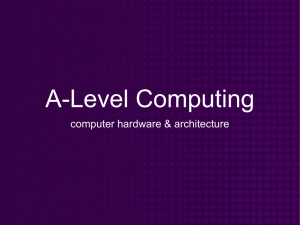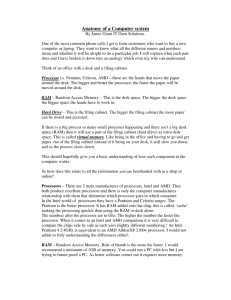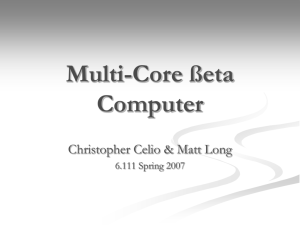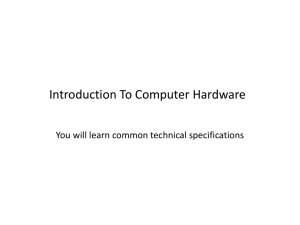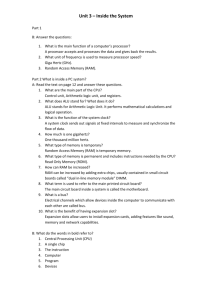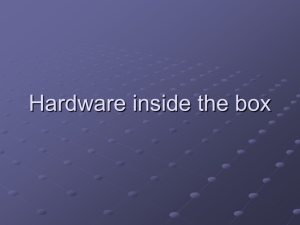PowerPoint
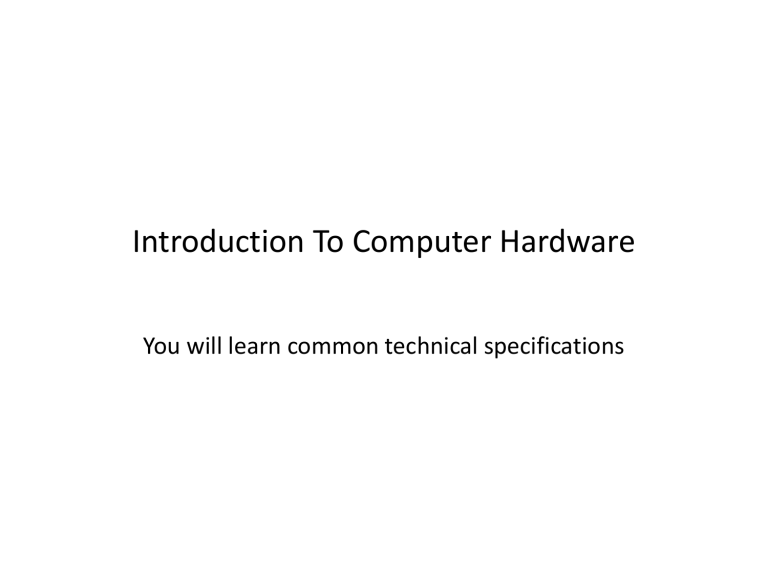
Introduction To Computer Hardware
You will learn common technical specifications
Technical Specifications
• As mentioned this version of this course will focus on more practical benefits than previous versions.
• So rather than presenting a long list of hardware specifications and how things work for it’s own sake, the focus will be on providing some of the information you will see when actually buying a machine.
– However due to brevity - a complete computer buyer’s guide would constitute a complete (continuing education) lecture only a subset of some of the more pertinent/common specifications will be covered.
Slide 2
Example Technical Specifications
• Paraphrased from an online electronics retailer:
– 3.5GHz 4th generation AMD A8 6500K processor and 6GB of RAM will keep you productive and efficient!
– 1TB hard drive provides roomy storage for your files, music, videos, and more!
– USB, VGA, and HDMI connectivity
– DVD RW 24X optical drive offers an additional storage option
– Last accessed from www.bestbuy.ca
Jan 2015
Slide 3
Which Type Of Computer Is For You?
• No single model (let alone manufacturer ) is best for everyone
• Ask yourself how you will use your machine, what things are the most important to you:
– Portability?
– Touch screen capability?
– Will you run programs that will push your system, e.g., video editing, gaming, image and 3D graphic editing (“hardware intensive”) or will you use your computer mainly for common tasks (e.g., word processing)
– Is gaming in general (even ones that don’t ‘push’ your system) important?
• If so consider a computer that is more commonly used.
– Future expandability and upgrade capability of your machine?
Slide 4
Tablets
• The lightest and most portable
• Touch interface:
– Good/bad issues
• Good for ‘light’ work
– Price : performance not the best among the categories
From: http://gadgetynews.com
(2015)
Slide 5
Laptops/Notebooks
• Compared to tablets:
– Usually larger display area
– Adds CD or DVD as well as a physical keyboard but may include touch capability as well
• Compared to desktops:
– Portability
– Price/performance, future expandability, choice of hardware not as good
If you’re interested in some comparisons of cheap laptops vs. tablets (focus on general technical and interaction issues over a model vs. model comparison)
• http://www.ehow.com/info_8721028_difference-between-tablet-pcnetbook.html
• http://www.pcadvisor.co.uk/buying-advice/tablets/3450587/netbook-vstablet/
• http://blogs.canoe.ca/canoetech/signs-of-the-times/netbooks-vs-tablets/
Image: curtesy James Tam
Slide 6
“Specialized/Variant Laptops”
• Ultrabooks
– Ultra = thinner and lighter (increased portability)
– All things being equal cost tends to be higher than a laptop
(manufacturing in exact detail)
• Netbooks
– Net = focus on Internet-related activities over long and intensive sessions on the computer (display area, hardware power).
– Much less common with the rise of tablets but still the cheapest option if a built in physical keyboard is desired
– Some common features on regular laptops are excluded (internal
CD/DVD drive)
Slide 7
Desktop Tower Computers
• Everything is separate (monitor, computer etc.)
– Allows for mixing and matching but more complex connections and it’s not portable).
– Faulty components can be more easily replaced.
• Larger ‘foot print’:
– More space required
– One benefit: greater expandability
– Compared to portable laptops and tablets: Reduced costs/more options
Image: curtesy James Tam
Slide 8
“All-In-One-Computers”
• Although technically this includes tablets and laptops this is an actual category (commonly used term).
– As the name implies everything is included together: monitor, computer, memory, storage
• Commonly chosen when:
– A desktop is desired but space is tight
– Some portability is desired (better than a desktop but not as good as a laptop)
• Somewhere in the middle between desktops and laptops in the balance between portability and hardware capabilities/power
Images (all accessed in 2015)
• Apple computer: James Tam
• HP computer: http://gadgetynews.com/hp-omni-hd-allinone-pc-beats-audio-quadcore-power
• Inside the case:
Slide 9
The Operating System (O/S): Purpose
• Runs the computer
– Intermediary between the physical hardware and the software
• Determines factors such as:
– The interface: familiarity, ease of use
– Configurability of the computer “tweakability”
– Security
Slide 10
The Operating System (O/S): MS-Windows “PC”
• Most popular operating system for ‘traditional’ computers
(desktop, laptops)
– You have the greatest chance of finding a program or hardware on this operating system
• Provides a high degree of flexibility ‘tweaking’
• The popularity of Windows combined with how it allows programmers increased ability to tweak things can increase the probability of a security-issue (e.g., virus)
Slide 11
The Operating System (O/S): MAC
• Some find it’s interface more “User friendly”
• Some also find it more challenging to tweak/customize:
– “Focus on consistency”: The operating system presents you with what the designers think you need to see (must sometimes dig) to find the rest or to change defaults
• The fact that the operating system is less commonly used and software programmers are more constrained (e.g., a fairly stringent approval mechanism by Apple before an app may be posted in the “App store”) makes it less likely (but not impossible) to encounter security-related issues:
– https://developer.apple.com/app-store/review/guidelines/
• Also note that similar to other operating systems, securityrelated problems can occur because of the operating system itself (unaffected by the vetting of the App store)
Slide 12
– http://www.forbes.com/sites/amitchowdhry/2014/12/26/why-apple-
The Operating System (O/S): Google Chromebook
• Mostly meant for online activities and running simpler applications (apps)
– Tends to be less expensive (functionality and perceived value of Windows and MAC-OS comes with a cost)
• Probably not the best choice if you regularly use desktop/laptop software often: gaming, image editing (e.g.,
Photoshop), word processing etc.
Slide 13
Large Units Of Measurement
• Example usage: 3.5GHz processor (G = Giga, Hz = processor oscillation speed)
– Kilo: One thousand 1,000
– Mega: One million 1,000,000
– Giga: One billion 1,000,000,000
– Tera: One trillion 1,000,000,000,000
• Large units of measurement will be discussed again when processors and storage devices are covered
Slide 14
Basic Units Of Storage
• On the computer all information is stored in binary (2 states e.g., on/off, pitted surface/smooth surface, connected/disconnected circuit)
• A single off/off combination is referred to as a ‘bit’ (binary digit) off on
• 8 bits grouped together is referred to as a ‘byte’
Slide 15
Large Units Of Measurement And Storage
• The amount of information that can be stored and transferred is typically measured in bytes rather than bits.
• Kilobyte (KB) ~ a thousand bytes (1,024 = 2 10 )
X 1,000
• Low quality preview ‘thumbnail’ images may range from a few thousand to tens of thousands of bytes in size.
• Megabyte (MB) ~ a million bytes (1,048,576 = 2 20 )
X 1,000,000
• A typical image may range from ~20,000 Bytes / 20 KB to several million bytes (MB).
• Audio files (e.g., MP3) are several Megabytes in size.
• Streaming Internet video (compressed) ~several hundred Megabytes for a full movie.
Slide 16
Large Units Of Measurement And Storage (2)
• Gigabyte (GB) ~ a billion bytes (1,073,741,824 = 2 30 )
X 1,000,000,000
1000 images or 100 MP3 songs (1 MB image, 10 MB MP3)
~ 30 minutes of DVD quality video (~1/4 of the information stored on a typical DVD)
• Terabyte (TB) ~ a trillion bytes (1,099,511,627,776 = 2 40 )
X 1,000,000
1 million images or 100,000 MP3 songs
~ 200 regular DVD’s (~32 Blu-ray) of information
Slide 17
Most Important Pieces Of Hardware
• (This refers to hardware that distinguishes one computer from another computer, other pieces such as hardware such as some sort of network connection is also crucial but not really different from computer-to-computer).
• Processor (CPU – or the APU for some AMD models)
• Memory (RAM)
• Storage (hard drive)
Slide 18
Processors: Clock speed
• It’s the speed at which the processor operates (oscillation rate)
• Typical home-type computers (e.g., laptops, desktops) operate at low single digit unit Giga-clock speeds ~1 to 4 GHz
– Note: Other than clock speeds there’s other factors that determines how fast a processor will run a program but all other things being equal a processor with a higher clock speed will run faster.
Slide 19
Processors: Multi-Core
• (Not to be confused with the model name of some Intel processors e.g., Core i3, Core i5, Core i7 etc.)
– AMD manufacturers multi-core processors as well
• The number of cores determines how many tasks that a computer can execute at the same time.
• Single core computer:
– Only appears to work on multiple tasks simultaneously.
Video editing Playing a video game
Pause
Images: curtesy James Tam
Slide 20
Processors: Multi-Core (2)
• Dual-core processors: can work on two tasks simultaneously
First processing core:
Video editing
Second processing core:
Playing a video game
Slide 21
Processors: Multi-Core (3)
• Other multi-core processors:
– Quad core : 4 processing cores
– 6 core
– 8 core
– For more information: comparing dual vs. quad core processors:
• http://www.pcmag.com/article2/0,2817,2406293,00.asp
Slide 22
Processors: Multi-Core (4)
• Having a processor with multiple cores can speed up execution even if only a single hardware intensive program (pushes the hardware of the computer) is running.
– The program is written specifically to take advantage of multi-core technology.
– Check the ‘system requirements’ or ‘technical requirements’ on the packaging or website e.g., Photoshop, Excel, Crysis (the video game)
First core: runs one part of game
Second core: runs another part of the same game
Slide 23
Will Multiple Cores Always Be Faster?
• Simple answer: it depends
• Advanced answer: look at actual computer usage
Slide 24
Intel Processor Models
1
• Another important factor determining execution speed
• Intel processor models:
– Pentium and Celeron (bargain basement entry level):
• Very old low end chips
• Unless you’re cash strapped avoid computers with these processors
– (JT: until part way through 2013 I was running one of these for my main computer tasks!)
– Core i3 (sensible entry level):
• Dual core processors
• For budget computers, good for basic every day computer use (word processing, browsing the web – you might want to avoid viewing videos extensively especially HD video)
Sources:
• http://www.cnet.com/topics/desktops/buying-guide/
• http://ark.intel.com/
• http://www.intel.com/content/www/us/en/processors/processornumbers.html
Slide 25
Intel Processor Models (2)
– Core i5 (good for most tasks/most users) Tam min
• Mainstream quad core processor line (a handful of lower end ones are dual core)
• Common in many desktop models and all-in-one computers
– Core i7 (for high end, powerful computer)
• Higher end processor for hardware-intensive tasks (e.g., games, video and image editing)
– For more information:
• http://ark.intel.com/
• http://www.intel.com/content/www/us/en/processors/processor-numbers.html
Slide 26
AMD Processor Models
• We won’t spend time on these lines but reference links are available for more information.
• AMD processors:
– http://www.amd.com/en-us/products/processors/desktop
• AMD vs. Intel: look at the speed tests performed with different software running (benchmarks).
– E.g., http://www.tomshardware.com/t/cpus/
• However brand definitely does matter in that you can’t freely mix and match between Intel and AMD.
Slide 27
Memory (RAM)
• When a computer program is executed the instructions as well as any data needed (e.g., images, videos) is loaded into RAM from the storage device (usually the hard drive).
• Temporary storage (gone when you shut off or restart your computer).
• Significantly faster than any storage device.
• More expensive on a per unit basis than a storage device such as a hard drive.
• The memory capacity of today’s computers are typically specified in single or double digit Gigabytes (recall that’s billions of bytes) .
Slide 28
How Much RAM?
Amount of RAM Primary computer usage
< 4 GB
Tam min 4 – 8 GB
10 GB and above
Basic: web browsing, email, word processing
Multitasking: running a few applications simultaneously, playing games, watching regular (lower definition) movies, simple photo editing.
Multitasking with regular applications or even with hardwareintensive applications such as games with higher resolution graphics (rules of thumb: “first person shooter” and/or 3D games rather than simpler adventure, role-playing, strategy games), video editing, 3D or extensive image editing (e.g.,
Photoshop), HD (high definition) entertainment
Slide 29
Storage (Hard Drive)
• All data that’s needed in the long term must be kept in some form of storage device.
– Storage (hard drive): something that may not currently be needed but needed at some point in the future.
– Memory (RAM): something that is currently being used must be stored here.
– Types of hard drives:
• Magnetic hard drives
– Stores information via magnetism
• Solid state hard drives
– Stores information without moving parts
• The typical storage capacity of hard drives is measured in hundreds of Gigabytes or single digit Terabytes
Slide 30
Comparison Of Hard Drive Types
Magnetic hard drive (HDD)
• Slower
• Less expensive
• Hard drives with the highest capacities are only magnetic
• Less ‘durable’ (may be affected by magnetic fields, physical jarring, temperature extremes)
Solid state hard drive (SSD)
• Faster (roughly double)
• More expensive
• Lower maximum storage capacity
• More durable (no moving parts)
640 GB
750 GB
1 TB
2 TB
3 TB
4 TB
Capacity Images (number): assume 1 MB per image
Songs (number): assumes 10 MB per song
Movies (hours): assumes 70
MB/hour
HD Movies
(hours): assumes
2.4 GB/hour
256 GB 256,000 25,600 3657 107
320 GB
500 GB
320,000
500,000
32,000
50,000
4571
7143
133
208
(SSD)
Tam range
640,000
750,000
1,000,000
2,000,000
3,000,000
4,000,000
64,000
75,000
100,000
200,000
300,000
400,000
9143
10714
14286
28571
42857
57143
267
313
417
833
1250
1667
(Magnetic)
Tam range
Slide 32
Hard Drive Tips
• Bigger is often better: even higher capacity drives have come down significantly in price.
• But for magnetic drives balance: storage capacity vs. speed
(higher capacity drives tend to have lower rpm – slower revolution speed)
• Or combine an SSD for speed with a magnetic drive for its high storage capacity (store smaller files than are less frequently accessed here).
Slide 33
Optical Drives
• CD/DVD?
– Do you play or rip music/videos?
– If the answer is no then I might not bother (or at least live with just a single drive)
Slide 34
Ports
• Connections to external devices.
• USB (standard): get as many as possible, ‘hub’ devices don’t always work as well as advertised.
• USB 3.0: need a few of these for USB 3.0 compatible external hard drives (backup of large amounts of data).
• HDMI: allow display on a TV monitor or connections to some peripherals (cable box, game consoles)
• SD: can be useful for connecting to some peripherals (devices that use SD cards such as cameras, e-readers, tablets)
• (Other important ports e.g., video, audio, network are given in computers today)
Slide 35
After This Section You Should Now Know
• The different category of computers and computing devices: tablets, notebooks/laptops, ultrabooks, netbook, desktop allin-ones as well as some of their strengths
• What is an operating system, what is its purpose
• The large units of measurement and how they apply to computer specifications
• The basic units of storage: bits and bytes and how the groupings of bytes applies to hardware
• Processor clock speed and reasonable values for computers of today
• The effect of multiple processing cores on speed
Slide 36
After This Section You Should Now Know (2)
• What is the function of RAM, how does it work, how it related to storage, what are reasonable amounts for computers of today
• What the two main types of storage technology (magnetic and
SSD) and how they compare, what is a reasonable amount for today’s computer usage
• Common computer ports
Slide 37
Gaming Or Multi-Media Computers
• Games and video/image editing software requires powerful hardware with large storage capacities:
• Rules of thumb:
– Processor: multicores such as Intel Core i5/i7, and AMD's
A6/A8/A10 and FX-series chips get a 6 core processor if you can afford it.
– RAM: Minimum 6 – 8 GB
– Ports: USB 3.0 can be handy (increased data transfer rates to external devices).
– A dedicated graphics card is a must (and not one that is just builtin)
• http://www.tomshardware.com/reviews/gaming-graphics-card-review,3107.html
• http://gamingpchardware.hubpages.com/hub/best-new-graphics-cards
Image: curtesy James Tam
Slide 38
The Machines Of Tam
Pre 2013
• 2.66 GHz Celeron
• 1 GB RAM
• 512 GB (originally ~80 GB)
• Integrated graphics and sound (built into the motherboard and not separate cards)
•
•
2013+
• i-3960x (6 cores, 3.3 GHz)
• 32 GB RAM
• 512 GB SSD
• 1 TB HDD (but with several high capacity external USB drives)
Graphics: NVIDIA GeForce
GTX 690
Sound: SB Recon 3D PCIe
P.S. for most of my CPSC undergraduate days I used an old Amiga2000HD: 7.14
MHz CPU, 1 MB chip RAM, 4 MB fast RAM, 1 GB hard drive, 32 kilobit modem
Additional Sources Of Information
• Online buying guides:
– http://www.pcmag.com/article2/0,2817,2357400,00.asp
– http://www.bestbuy.ca/en-CA/research/desktop-computer-buyingguide/rc8771.aspx
– http://www.amazon.com/gp/feature.html?ie=UTF8&docId=1000863131
• Detailed technical specifications:
• (Processors)
– http://www.intel.com/content/www/us/en/processors/processor-numbers.html
– http://products.amd.com/en-us/DesktopCPUResult.aspx
Slide 40
slide 41
Copyright Notification
• “Unless otherwise indicated, all images in this presentation are used with permission from Microsoft.”
Slide 41
